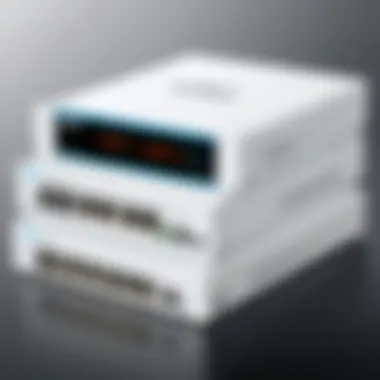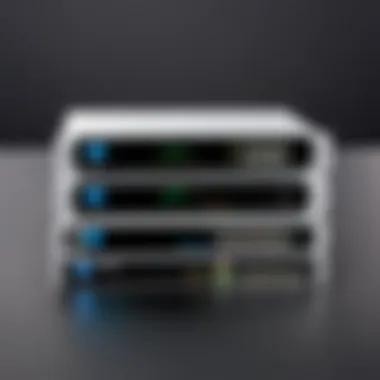Unifi Switch Pro 24 PoE vs Unifi Switch 24 PoE: A Comparative Study


Intro
The demand for reliable networking devices has surged in today's digital age. For businesses and tech enthusiasts alike, understanding the distinctions between products is vital. This article delves into two significant offerings from Ubiquiti: the Unifi Switch Pro 24 PoE and the Unifi Switch 24 PoE. By examining their features, performance metrics, pricing, and applications, this comparative analysis aims to equip potential buyers with a comprehensive understanding of these devices, ultimately aiding in informed procurement decisions.
Software Overview
The Unifi Switch Pro 24 PoE and the Unifi Switch 24 PoE operate using the Unifi Controller software, which is critical for managing and monitoring network devices.
Purpose and function of the software
This software enables users to efficiently configure, optimize, and troubleshoot their networking devices remotely. The Unifi Controller provides a centralized interface from which administrators can manage multiple switches along with other Unifi products, such as access points and routers. This is particularly crucial for maintaining consistent performance and security across a network.
Key features and benefits
The Unifi Controller has several benefits:
- User-Friendly Interface: The controller offers a streamlined dashboard that simplifies network management.
- Real-Time Monitoring: Users can monitor traffic, device statuses, and performance metrics in real-time.
- Custom Analytics: Provides insights into network usage and user behavior, guiding adjustments for enhanced performance.
- Scalability: Easily integrates new devices as the network grows without significant hassle.
Installation and Setup
Installing the Unifi Switch Pro 24 PoE and Unifi Switch 24 PoE requires certain system prerequisites and a clear process.
System requirements
Before beginning the installation, ensure that your network meets the following requirements:
- Power Supply: Both switches require an adequate PoE power source or a power adapter.
- Network Environment: A stable Internet connection for setup and updates.
- Compatible Devices: Ensure connected devices can support PoE modes if utilizing PoE functionality.
Installation process
The installation process is fairly straightforward:
- Connect to Power: Ensure the switch is powered on.
- Network Connection: Utilize Ethernet cables to connect devices to the switch.
- Access the Controller: Open the Unifi Controller on a computer or mobile device to configure the new switch.
- Follow Configuration Prompts: Complete the setup by following on-screen instructions.
Overall, both the Unifi Switch Pro 24 PoE and Unifi Switch 24 PoE are robust solutions for network management, particularly for organizations requiring flexible power options and efficient device handling. By understanding their specifications and functionalities, users can make well-informed choices suitable for their networking needs.
Preamble to Networking Solutions
In today’s interconnected world, networking solutions are pivotal in ensuring seamless communication and data transfer. They form the backbone of any modern IT environment, whether in small businesses or large enterprises. Understanding networking solutions helps users grasp how devices communicate, share resources, and maintain operational efficiency. This article delves into two specific networking devices: the Unifi Switch Pro 24 PoE and the Unifi Switch 24 PoE. Through a comparative analysis, we aspire to inform readers about their distinctive features, performance metrics, and application relevances.
The Role of Network Switches
Network switches play an integral role in how devices communicate within a network. They are responsible for connecting devices like computers, printers, and servers to create a network. Without switches, devices would be unable to interact effectively, leading to inefficiencies and increased latency.
- Switches manage data flow between devices. They function by receiving incoming data packets and forwarding them to their destination based on MAC addresses. This targeted approach reduces the chances of data collisions and enhances network performance.
- Managed switches, such as those in the Unifi line, provide advanced control features, giving users the ability to configure settings, monitor traffic, and troubleshoot issues.
- Additionally, switches can support Power over Ethernet, enabling them to deliver power alongside data over the same cables. This capability is crucial for devices like IP cameras and VoIP phones, simplifying installation.
Understanding Power over Ethernet (PoE)
Power over Ethernet (PoE) is an innovative technology that simplifies network installations. By transmitting both power and data through a single cable, PoE reduces the need for separate power sources for network devices. This results in cleaner installations and offers flexibility for device placement.
- PoE technology is categorized into several standards. These standards dictate the amount of power that can be transmitted through Ethernet cables. The most common standards are IEEE 802.3af, 802.3at (PoE+), and 802.3bt (PoE++). Each standard supports varying maximum power outputs ranging from 15.4 watts to over 60 watts.
- Not only does PoE minimize installation costs, but it also enhances safety. Devices can be located in areas where traditional power outlets are absent, thus expanding deployment opportunities.
- Moreover, PoE contributes to overall energy efficiency by allowing devices to be powered down or reset remotely, ensuring energy is used only when needed.
In summary, a solid grasp of networking solutions, including the functionalities of network switches and PoE technology, sets the stage for understanding and effectively utilizing devices such as the Unifi Switch Pro 24 PoE and Unifi Switch 24 PoE. This foundational knowledge is essential for anyone involved in IT, network administration, or related fields.


Overview of Unifi Switch Pro PoE
In the discussion of modern networking solutions, the Unifi Switch Pro 24 PoE holds a significant place. This equipment offers enhanced features and flexibility compared to its counterparts. Understanding its functionality can help IT professionals, developers, and students see its value in various networking scenarios. This section will provide insights into the unique characteristics of the Unifi Switch Pro 24 PoE, including its key features, technical specifications, and performance metrics. By analyzing these elements, readers can appreciate its relevance in contemporary network design and management.
Key Features
The Unifi Switch Pro 24 PoE is designed with several distinctive features that cater to various networking needs. Some key highlights include:
- PoE Support: Power over Ethernet allows this switch to deliver power and data through the same cable, enhancing installation efficiency.
- Advanced Layer 2 Capabilities: It includes features such as VLAN support that allows for better traffic management and isolation.
- SFP+ Uplinks: This switch has SFP+ ports for high-speed uplink options which improve overall network performance.
- Management Options: The integrated management interface provides robust monitoring capabilities that are essential for network troubleshooting and optimization.
These features offer not only convenience but also improve the overall networking experience for users.
Technical Specifications
Understanding the technical specifications is vital for assessing how the Unifi Switch Pro 24 PoE can fit into specific network environments. Some notable specifications include:
- Ports: 24 Gigabit Ethernet ports with 802.3at PoE support.
- Power Budget: A power budget of 400 Watts.
- Layer: Operates at Layer 2.
- Forwarding Capacity: High throughput, allowing for effective data transmission.
These specifications illustrate the capacity of the switch and its potential to handle demanding networking demands.
Performance Metrics
Evaluating performance metrics reveals how well the Unifi Switch Pro 24 PoE performs under different loads. It demonstrates:
- Latency: Minimal latency levels, contributing to a responsive network.
- Throughput: The switch supports high throughput levels, making it suitable for data-intensive applications.
- Scalability: Its design accommodates scaling, ensuring future network requirements can be met with ease.
In summary, the Unifi Switch Pro 24 PoE presents a comprehensive solution for building efficient network infrastructures, and recognizing these details aids in making informed purchasing decisions.
Overview of Unifi Switch PoE
The Unifi Switch 24 PoE is a significant player in the market of network switches for both small and medium-sized networks. Understanding this device is crucial for IT professionals and system integrators aimed at enhancing their network infrastructure. This switch presents a balance of power, performance, and flexibility, making it an attractive option for many users.
When evaluating networking solutions, one must consider not just the device itself, but also how it fits into a larger system. The Unifi Switch 24 PoE is built to simplify deployment in environments that demand both data and power over Ethernet. Its ability to support Power over Ethernet enhances its functionality and broadens its applications in configuring connected devices such as IP cameras, access points, and VoIP phones.
Key Features
The Unifi Switch 24 PoE offers several standout features:
- PoE Support: This switch provides up to 24 PoE+ ports, which can deliver both data and electrical power.
- Managed Switching: It is a managed switch that allows for deep analytics and control over network traffic.
- Interface Options: Supports various interface types including SFP for fiber connectivity.
- Modular Design: The switch's architecture supports easy upgrades and expansion.
- User-Friendly Management: Integrated into the Unifi Controller software, the management is intuitive and streamlined.
Each of these features contributes to creating a robust networking solution for different use cases.
Technical Specifications
Understanding the technical specifications is key to analyzing the capabilities of the Unifi Switch 24 PoE. Key specifications include:
- Total Ports: 24 Gigabit Ethernet ports.
- PoE Budget: 250W total power budget for PoE devices.
- Switching Capacity: 48 Gbps.
- Fanless Design: Ensures silent operation, making it ideal for office environments.
- Dimensions: Standard 1U form factor for easy rack mounting.
These specifications dictate performance in real-world applications and highlight the switch’s reliability in high-demand settings.
Performance Metrics
Performance metrics for the Unifi Switch 24 PoE are critical to understanding its effectiveness in various scenarios.


- Throughput: With a switching capacity of 48 Gbps, the switch efficiently handles multiple simultaneous connections without bottlenecks.
- Latency: Latency remains minimal, crucial for applications where real-time data is essential.
- Power Efficiency: The power budget allows numerous devices to operate while maintaining energy efficiency.
- Traffic Management: VLAN support allows for effective network segmentation, enhancing security and performance.
Understanding these performance metrics enables network administrators to deploy the Unifi Switch 24 PoE with confidence in its capabilities.
Comparative Analysis of Specifications
The comparative analysis of specifications serves a critical role in understanding the functionalities and limitations of network devices. In this section, we will delve into the specific characteristics that differentiate the Unifi Switch Pro 24 PoE from the Unifi Switch 24 PoE. Identifying these distinctions aids in making informed decisions tailored to specific network conditions and requirements. Understanding these specifications allows users to gauge performance levels, potential applications, and overall suitability for various environments.
Port Configuration
Port configuration is a fundamental element for networking devices. For the Unifi Switch Pro 24 PoE, it offers a robust 24-port arrangement, which provides flexibility in deploying multiple devices within a network. Each port supports Power over Ethernet, reducing the need for separate power cabling for devices such as IP cameras and VoIP phones. The Unifi Switch 24 PoE, while similar in port count, might offer variations in additional capabilities like link aggregation.
In terms of management, the Pro model allows for more advanced settings, enabling network administrators to configure VLANs and QoS policies directly through its interface. This can be beneficial in high-demand environments, where traffic management is crucial. Conversely, the Unifi Switch 24 PoE is more streamlined, potentially ideal for simpler networks where advanced configuration is not a feature priority.
Power Budgeting
When it comes to power budgeting, the Unifi Switch Pro 24 PoE significantly excels. It has a higher total power output capacity, enabling it to efficiently support devices with greater power needs. This is particularly important in scenarios where multiple high-consumption devices are deployed. On the other hand, the Unifi Switch 24 PoE offers a more moderate power budget, making it suitable for less demanding applications.
Proper power budgeting ensures that no single device exceeds its power allocation, which could lead to instability or device failure. By analyzing power budgeting specifications, network designers can avoid potential issues related to underutilization or overstress of network equipment. This careful planning is increasingly critical in more complex setups, including those that incorporate high-definition video surveillance or extensive IoT deployments.
Throughput Capabilities
Throughput capabilities represent the maximum amount of data that can pass through the switch at any given time. The Unifi Switch Pro 24 PoE is often credited with higher throughput performance compared to its counterpart. This might be advantageous in environments where large data transfers occur regularly, such as in data centers or enterprise networks.
The metrics associated with throughput metrics help in identifying the best fit for network requirements. For example, the Pro model may support higher bandwidth applications, leading to more efficient data handling. In contrast, the Unifi Switch 24 PoE targets smaller setups, where lower throughput is acceptable. Evaluating these specifications can help organizations match equipment with their specific operational needs, ensuring they are optimized for efficiency.
Understanding specifications is vital in ensuring that networking equipment meets the intended demands of a given environment.
Analyzing the different aspects of port configuration, power budgeting, and throughput capabilities will clarify which model best serves particular networking objectives. A meticulous examination of these elements can lead to a more effective networking solution, tailored to the demands of modern technology.
Application Scenarios
Understanding the application scenarios of the Unifi Switch Pro 24 PoE and the Unifi Switch 24 PoE is vital for potential users. This section focuses on how these devices can be optimally utilized in diverse environments, highlighting specific requirements and considerations.
The application scenarios inform not only the selection of the switch but also the planning of the overall network architecture. Selecting the right switch ensures reliable performance and efficient power management. Furthermore, analyzing different scenarios helps prevent future issues and allows for scalable network solutions.
Best Use Cases for Unifi Switch Pro PoE
Unifi Switch Pro 24 PoE is designed for environments that demand high performance and scalability. Here are some optimal use cases:
- Enterprise Networks: In companies with a large number of devices, the Unifi Switch Pro allows for enhanced throughput and stronger power delivery across multiple access points, cameras, and VoIP phones.
- Remote Work Environments: With the rise of remote work, having seamless connectivity at home offices that require multiple devices is crucial. The power over Ethernet feature can simplify installation and cut down on cable clutter.
- Educational Institutions: Schools that require network connections for many classrooms can benefit from this switch, supporting interactive displays and other electronic teaching tools. The ability to manage traffic efficiently reduces downtimes during class hours.
Best Use Cases for Unifi Switch PoE
On the other hand, the Unifi Switch 24 PoE offers suitable functionalities for different contexts. Some of its best use cases include:
- Small to Medium-sized Businesses (SMBs): These businesses often require standard options without extensive requirements. The Unifi Switch 24 PoE provides sufficient performance for internet connectivity while maintaining cost-effectiveness.
- Home Automation Systems: Homes with smart devices and cameras can utilize the Unifi Switch 24 PoE when needing a central connection point. This ensures stable connectivity without excessive installations.
- Retail Settings: Stores looking to manage point-of-sale systems alongside security cameras find the Unifi Switch 24 PoE advantageous. The switch helps efficiently route power and data, keeping operations running smoothly.
Ultimately, identifying and understanding these application scenarios can lead to informed decisions about which switch is the best fit for a specific network's needs.
Cost Analysis
In any networking environment, understanding the financial implications of equipment acquisition is critical. The Cost Analysis section of this article delves into the intricacies of what it means to invest in networking hardware, specifically the Unifi Switch Pro 24 PoE and the Unifi Switch 24 PoE. This analysis encompasses not just the initial cost of purchase, but also how each device's long-term costs can influence overall network efficiency and budget management.


Pricing Structures
When considering the pricing structures of the Unifi Switch Pro 24 PoE and Unifi Switch 24 PoE, there are a few points to evaluate.
- Initial Cost: The Unifi Switch Pro 24 PoE typically carries a higher price point compared to the Unifi Switch 24 PoE. This difference reflects its enhanced features and capabilities, which can justify the investment for more demanding networking requirements.
- Included Features: The Pro version offers managed switch capabilities, while the regular version is more basic. Depending on the existing infrastructure, the initial higher investment in the Pro model may lead to significant savings over time due to its advanced functionality.
- Licensing Fees: For systems using UniFi Network Controller software, the Pro version may require licensing. However, it provides additional functionalities that may be necessary for larger networks. Understanding these costs upfront helps in preparing a more accurate budget.
In short, potential buyers should carefully examine what they need from their switch and balance it against their financial constraints to choose the right model.
Long-Term Cost Efficiency
Long-term cost efficiency is a pivotal metric in assessing the value of any networking solution. Investing in a more sophisticated model like the Unifi Switch Pro 24 PoE can have several benefits that might not be immediately obvious.
- Energy Efficiency: The Pro model generally has better energy management features, which can lead to lower electricity costs over time.
- Operational Reliability: With more robust performance, the Pro model can reduce downtime, resulting in lower operational costs and lost productivity.
- Scalability: The flexibility offered by the features in the Pro model can reduce future costs related to scaling. Investing in a device that can grow with your network saves both time and money in the long run.
Moreover, investing in equipment that allows for easier upgrades or expansions means that businesses can avoid frequent replacements or significant reinvestments. This aspect should not be overlooked when weighing the differences in price between the two models.
In the end, a careful cost analysis includes both initial purchase price and the long-term implications of that investment.
In summary, a comprehensive look at cost structures and long-term efficiency informs users about the financial commitment involved in selecting the correct networking switch. Through examination of these vital elements, decision-makers can make better-informed choices that enhance overall performance and budget management.
User Experience and Reviews
User experience and reviews play a crucial role in understanding the effectiveness and reliability of networking devices such as the Unifi Switch Pro 24 PoE and the Unifi Switch 24 PoE. In today’s technology landscape, these factors often influence purchasing decisions and help prospective buyers gauge how well a specific device meets their needs. Understanding user experiences can provide insights beyond specifications, revealing the real-world performance of each switch.
Experience encompasses a range of elements, including usability, reliability, and overall performance. It provides a picture of how these switches perform in actual conditions, rather than under ideal scenarios outlined in technical documentation. A switch might appear powerful on paper, but its real-world application can shed light on any limitations and efficiencies. This analysis looks to present a fair representation of these aspects, offering readers informed advice.
Manufacturer Support
Manufacturer support is a determining factor in the ownership experience of networking devices. For both the Unifi Switch Pro 24 PoE and the Unifi Switch 24 PoE, the availability and responsiveness of support from Ubiquiti Networks is worth exploring.
An efficient support system can enhance user satisfaction significantly. Ubiquiti provides several resources, including:
- Documentation: Comprehensive manuals and knowledge bases are available online, which assist users in understanding configurations and troubleshooting common issues.
- Firmware Updates: Regular updates address bugs, introduce new features, and enhance security, which are essential for maintaining optimal device performance.
- Community Forums: Ubiquiti hosts forums where users can exchange experiences, ask questions, and find solutions to issues. This can prove invaluable for troubleshooting and learning from other users’ insights.
However, it is essential to gauge the consistency of this support. Users often report varying experiences with response times and helpfulness. While some may find the support robust, others could experience delays in resolving critical issues. This inconsistency is a vital consideration for prospective buyers.
Community Feedback
Community feedback serves as another important element in the overall user experience of the Unifi Switches. The size and vibrancy of the user community can significantly influence the effectiveness of the support system. The evolution of online platforms such as Reddit and specialized user forums allow individuals to share their thoughts and experiences.
Feedback on the Unifi Switch Pro 24 PoE often revolves around:
- Performance Satisfaction: Users frequently share their satisfaction regarding throughput and reliability, particularly in demanding environments.
- Software Usability: Many users discuss their experiences with the Unifi Controller, its ease of use, and the ability to manage multiple devices through a single interface. This aspect becomes a common highlight in discussions.
- Power over Ethernet Performance: The effectiveness of PoE delivery in various scenarios is another hot topic. Users weigh in on whether the power budget meets their expectations.
Community reviews can sometimes differ from official capabilities. They offer nuanced perspectives based on various environments, making it easier for potential customers to match a switch's capabilities with their unique situations. Ultimately, this shared knowledge can enhance buyer confidence and decision-making.
End
In this article, we explored two significant models in the networking equipment market: the Unifi Switch Pro 24 PoE and the Unifi Switch 24 PoE. A proper conclusion integrates the main findings and emphasizes the relevance they have for prospective buyers and technology experts.
Both switches exhibit powerful capabilities that cater to diverse networking needs, but they do so through different specifications and applications. The understanding of these distinctions is crucial for anyone tasked with selecting the right switch for their network.
Final Recommendations
When it comes to making a choice between the two models, several considerations come into play.
- Use Case: If you are operating in an environment where advanced features such as Layer 3 capabilities are critical, the Unifi Switch Pro 24 PoE may be a better fit.
- Budget: Evaluate your budgetary constraints carefully. The Unifi Switch 24 PoE offers essential features at a lower price, making it suitable for smaller networks or users not needing advanced capabilities.
- Scalability: Consider future network growth. If expansion is on the horizon, investing in the Unifi Switch Pro 24 PoE could save time and resources down the line.
Ultimately, the decision should align with both current needs and future goals. Developing a thoughtful procurement strategy can greatly simplify the networking process.



